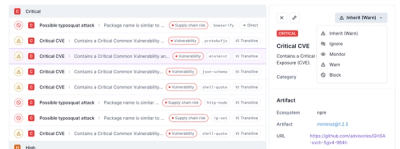
Research
Security News
Malicious npm Package Typosquats react-login-page to Deploy Keylogger
Socket researchers unpack a typosquatting package with malicious code that logs keystrokes and exfiltrates sensitive data to a remote server.
@angular-devkit/schematics
Advanced tools
Package description
@angular-devkit/schematics is a powerful tool for creating and managing code transformations in Angular projects. It allows developers to automate tasks such as generating components, services, and other Angular constructs, as well as performing code modifications and migrations.
Generating a Component
This feature allows you to generate a new Angular component by creating the necessary TypeScript file with a basic component structure.
const { Rule, SchematicContext, Tree } = require('@angular-devkit/schematics');
function createComponent(options) {
return (tree, _context) => {
const content = `import { Component } from '@angular/core';
@Component({
selector: 'app-${options.name}',
templateUrl: './${options.name}.component.html',
styleUrls: ['./${options.name}.component.css']
})
export class ${options.name.charAt(0).toUpperCase() + options.name.slice(1)}Component { }
`;
tree.create(`/src/app/${options.name}/${options.name}.component.ts`, content);
return tree;
};
}
module.exports = { createComponent };Updating a File
This feature allows you to update an existing file by replacing specified text with new text.
const { Rule, SchematicContext, Tree } = require('@angular-devkit/schematics');
function updateFile(options) {
return (tree, _context) => {
const filePath = options.path;
if (tree.exists(filePath)) {
const content = tree.read(filePath).toString('utf-8');
const updatedContent = content.replace(options.oldText, options.newText);
tree.overwrite(filePath, updatedContent);
}
return tree;
};
}
module.exports = { updateFile };Deleting a File
This feature allows you to delete a specified file from the project.
const { Rule, SchematicContext, Tree } = require('@angular-devkit/schematics');
function deleteFile(options) {
return (tree, _context) => {
const filePath = options.path;
if (tree.exists(filePath)) {
tree.delete(filePath);
}
return tree;
};
}
module.exports = { deleteFile };Yeoman Generator is a scaffolding tool that allows developers to create custom generators for various types of projects. It is more general-purpose compared to @angular-devkit/schematics, which is specifically tailored for Angular projects.
Plop is a micro-generator framework that allows developers to create custom generators for code scaffolding. It is simpler and more lightweight compared to @angular-devkit/schematics, making it suitable for smaller projects or those not specifically tied to Angular.
Hygen is a fast and lightweight code generator that allows developers to create custom templates and generators. It is similar to @angular-devkit/schematics in terms of functionality but is more focused on simplicity and ease of use.
Readme
A scaffolding library for the modern web.
Schematics are generators that transform an existing filesystem. It can create files, refactor existing files, or move files around.
What distinguish Schematics from other generators, such as Yeoman or Yarn Create, is that schematics are purely descriptive; no changes are applied to the actual filesystem until everything is ready to be committed. There is no side effect, by design, in Schematics.
| Term | Description |
|---|---|
| Schematics | A generator that execute descriptive code without side effects on an existing file system. |
| Collection | A list of schematics metadata. Schematics can be referred by name inside a collection. |
| Tool | The code using the Schematics library. |
| Tree | A staging area for changes, containing the original file system, and a list of changes to apply to it. |
| Rule | A function that applies actions to a Tree. It returns a new Tree that will contain all transformations to be applied. |
| Source | A function that creates an entirely new Tree from an empty filesystem. For example, a file source could read files from disk and create a Create Action for each of those. |
| Action | A atomic operation to be validated and committed to a filesystem or a Tree. Actions are created by schematics. |
| Sink | The final destination of all Actions. |
Schematics is a library, and does not work by itself. A reference CLI is available on this repository, but is not published on NPM. This document explain the library usage and the tooling API, but does not go into the tool implementation itself.
The tooling is responsible for the following tasks:
The tooling API is composed of the following pieces:
The SchematicEngine is responsible for loading and constructing Collections and Schematics'. When creating an engine, the tooling provides an EngineHost interface that understands how to create a CollectionDescription from a name, and how to create a SchematicDescription.
Schematics are generators and part of a Collection.
A Collection is defined by a collection.json file (in the reference CLI). This JSON defines the following properties:
| Prop Name | Type | Description |
|---|---|---|
| name | string | The name of the collection. |
| version | string | Unused field. |
A Source is a generator of Tree; it creates a root tree from nothing. A Rule is a transformation from one Tree to another. A Schematic (at the root) is a Rule that is normally applied on the filesystem.
FileOperators apply changes to a single FileEntry and return a new FileEntry. The result follows these rules:
FileEntry returned is null, a DeleteAction will be added to the action list.RenameAction will be added to the action list.OverwriteAction will be added to the action list.It is impossible to create files using a FileOperator.
| FileOperator | Description |
|---|---|
contentTemplate<T>(options: T) | Apply a content template (see the Template section) |
pathTemplate<T>(options: T) | Apply a path template (see the Template section) |
The Schematics library provides multiple Source factories by default that cover basic use cases:
| Source | Description |
|---|---|
source(tree: Tree) | Creates a source that returns the tree passed in argument. |
empty() | Creates a source that returns an empty tree. |
apply(source: Source, rules: Rule[]) | Apply a list of rules to a source, and return the result. |
url(url: string) | Loads a list of files from a URL and returns a Tree with the files as CreateAction applied to an empty Tree |
The schematics library also provides Rule factories by default:
| Rule | Description |
|---|---|
noop() | Returns the input Tree as is. |
chain(rules: Rule[]) | Returns a Rule that's the concatenation of other rules. |
forEach(op: FileOperator) | Returns a Rule that applies an operator to every file of the input Tree. |
move(root: string) | Moves all the files from the input to a subdirectory. |
merge(other: Tree) | Merge the input tree with the other Tree. |
contentTemplate<T>(options: T) | Apply a content template (see the Template section) to the entire Tree. |
pathTemplate<T>(options: T) | Apply a path template (see the Template section) to the entire Tree. |
template<T>(options: T) | Apply both path and content templates (see the Template section) to the entire Tree. |
filter(predicate: FilePredicate<boolean>) | Returns the input Tree with files that do not pass the FilePredicate. |
| `branch |
An example of a simple Schematics which creates a "hello world" file, using an option to determine its path:
import {Tree} from '@angular-devkit/schematics';
export default function MySchematic(options: any) {
return (tree: Tree) => {
tree.create(options.path + '/hi', 'Hello world!');
return tree;
};
}
A few things from this example:
Rule, which is a transformation from a Tree to another Tree.Schematics is not done yet. Here's a list of things we are considering:
FAQs
Unknown package
We found that @angular-devkit/schematics demonstrated a healthy version release cadence and project activity because the last version was released less than a year ago. It has 2 open source maintainers collaborating on the project.
Did you know?

Socket for GitHub automatically highlights issues in each pull request and monitors the health of all your open source dependencies. Discover the contents of your packages and block harmful activity before you install or update your dependencies.

Research
Security News
Socket researchers unpack a typosquatting package with malicious code that logs keystrokes and exfiltrates sensitive data to a remote server.

Security News
The JavaScript community has launched the e18e initiative to improve ecosystem performance by cleaning up dependency trees, speeding up critical parts of the ecosystem, and documenting lighter alternatives to established tools.

Product
Socket now supports four distinct alert actions instead of the previous two, and alert triaging allows users to override the actions taken for all individual alerts.